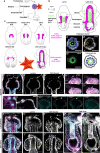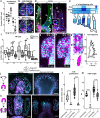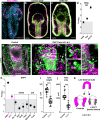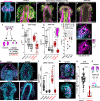Molecular mechanisms of tubulogenesis revealed in the sea star hydro-vascular organ
- PMID: 37160908
- PMCID: PMC10170166
- DOI: 10.1038/s41467-023-37947-2
Molecular mechanisms of tubulogenesis revealed in the sea star hydro-vascular organ
Abstract
A fundamental goal in the organogenesis field is to understand how cells organize into tubular shapes. Toward this aim, we have established the hydro-vascular organ in the sea star Patiria miniata as a model for tubulogenesis. In this animal, bilateral tubes grow out from the tip of the developing gut, and precisely extend to specific sites in the larva. This growth involves cell migration coupled with mitosis in distinct zones. Cell proliferation requires FGF signaling, whereas the three-dimensional orientation of the organ depends on Wnt signaling. Specification and maintenance of tube cell fate requires Delta/Notch signaling. Moreover, we identify target genes of the FGF pathway that contribute to tube morphology, revealing molecular mechanisms for tube outgrowth. Finally, we report that FGF activates the Six1/2 transcription factor, which serves as an evolutionarily ancient regulator of branching morphogenesis. This study uncovers distinct mechanisms of tubulogenesis in vivo and we propose that cellular dynamics in the sea star hydro-vascular organ represents a key comparison for understanding the evolution of vertebrate organs.
© 2023. The Author(s).
Conflict of interest statement
Synthego provided free samples of FGFR gRNAs. Other gRNAs and all other products used in this study were purchased at market value. The authors declare no other competing interests.
Figures








Similar articles
-
The skeletal proteome of the sea star Patiria miniata and evolution of biomineralization in echinoderms.BMC Evol Biol. 2017 Jun 5;17(1):125. doi: 10.1186/s12862-017-0978-z. BMC Evol Biol. 2017. PMID: 28583083 Free PMC article.
-
Escargot controls the sequential specification of two tracheal tip cell types by suppressing FGF signaling in Drosophila.Development. 2016 Nov 15;143(22):4261-4271. doi: 10.1242/dev.133322. Epub 2016 Oct 14. Development. 2016. PMID: 27742749 Free PMC article.
-
Expression of wnt and frizzled genes during early sea star development.Gene Expr Patterns. 2013 Dec;13(8):437-44. doi: 10.1016/j.gep.2013.07.007. Epub 2013 Jul 27. Gene Expr Patterns. 2013. PMID: 23899422
-
Planar cell polarity regulators in asymmetric organogenesis during development and disease.J Genet Genomics. 2023 Feb;50(2):63-76. doi: 10.1016/j.jgg.2022.06.007. Epub 2022 Jul 6. J Genet Genomics. 2023. PMID: 35809777 Review.
-
Vascular morphogenesis: a Wnt for every vessel?Curr Opin Genet Dev. 2009 Oct;19(5):476-83. doi: 10.1016/j.gde.2009.09.004. Epub 2009 Oct 26. Curr Opin Genet Dev. 2009. PMID: 19864126 Review.
Cited by
-
Sea cucumbers: an emerging system in evo-devo.Evodevo. 2024 Feb 17;15(1):3. doi: 10.1186/s13227-023-00220-0. Evodevo. 2024. PMID: 38368336 Free PMC article. Review.
-
Myotube Guidance: Shaping up the Musculoskeletal System.J Dev Biol. 2024 Sep 17;12(3):25. doi: 10.3390/jdb12030025. J Dev Biol. 2024. PMID: 39311120 Free PMC article. Review.
-
Local and global changes in cell density induce reorganisation of 3D packing in a proliferating epithelium.Development. 2024 Oct 15;151(20):dev202362. doi: 10.1242/dev.202362. Epub 2024 May 7. Development. 2024. PMID: 38619327 Free PMC article.
-
A molecular basis for spine color morphs in the sea urchin Lytechinus variegatus.Sci Rep. 2024 Nov 18;14(1):28518. doi: 10.1038/s41598-024-79312-3. Sci Rep. 2024. PMID: 39557917 Free PMC article.
-
The dynamics of tubulogenesis in development and disease.Development. 2025 Feb 1;152(3):DEV202820. doi: 10.1242/dev.202820. Epub 2025 Feb 17. Development. 2025. PMID: 39959988 Review.
References
Publication types
MeSH terms
Grants and funding
- K99 HD099315/HD/NICHD NIH HHS/United States
- R35 GM140897/GM/NIGMS NIH HHS/United States
- 1R35GM140897/U.S. Department of Health & Human Services | NIH | National Institute of General Medical Sciences (NIGMS)
- K99HD099315/U.S. Department of Health & Human Services | NIH | Eunice Kennedy Shriver National Institute of Child Health and Human Development (NICHD)
LinkOut - more resources
Full Text Sources
Research Materials
Miscellaneous

